Sequential Treatment of Domestic Wastewater in Rural Zones Applying Aloe Vera Extract as Coagulant (Preliminar), E. crassipes in a Horizontal Biofilter (Secondary), and Activated Carbon from Soursop Seeds (Tertiary)
Abstract
1. Introduction
2. Materials and Methods
2.1. Characteristics of Domestic Wastewater (DWW) and Materials Used
2.2. Characteristics of Materials Used
2.3. Methodological Approach and Tests Carried out
2.4. Experimental Design and Management Mode
- -
- E [mg/mL]: concentration of methylene blue solution.
- -
- V [mL]: volume of the methylene blue solution.
- -
- W [mg]: weight of activated carbon.
- -
- C0 [mg/L]: initial concentration of methylene blue solution.
- -
- Cf [mg/L]: final concentration of methylene blue solution.
- -
- V [L]: volume of the solution.
- -
- M V−1 [mg/L]: concentration of activated carbon.
3. Results and Discussion
3.1. Primariy Treatment—Evaluation of AVW: Optimum Dosage and Comparison with Aluminum Sulfate
3.2. HFB with EC as an Effective Secondary Treatment
3.3. Validate the Synthesis Process of the Selected SSW Adsorbent and Operating Conditions for Use as Tertiary Treatment
3.4. Analysis of Integration and Future Scenarios on a Pilot Scale
- -
- Primary treatment—AVW coagulation: turbidity removal 42%; pH maintained near neutrality; sustainable, biodegradable coagulant.
- -
- Secondary treatment—HFB with Eichhornia crassipes: fecal coliform reduction 97.9%, E. coli reduction 82.4%, heterotrophic bacteria reduction 99%; COD and BOD significantly decreased; mechanisms include filtration, sedimentation, biofilm activity, root oxygenation, and natural antimicrobial compounds.
- -
- Tertiary treatment—SSW adsorbent: methylene blue removal 99.7%; turbidity reduction up to 98%; performance comparable or superior to commercial activated carbon; utilizes agricultural waste, aligning with circular economy principles.
- -
- Technical and economic benefits: up to ~40% reduction in operational costs compared to chemical coagulants and commercial adsorbents; reduced environmental impact due to minimal chemical use and reuse of waste materials.
4. Conclusions
Author Contributions
Funding
Data Availability Statement
Acknowledgments
Conflicts of Interest
Abbreviations
| AVW | Natural coagulant from aloe vera waste |
| BOD | Biological oxygen demand |
| COD | Chemical oxygen demand |
| DWW | Domestic Wastewater |
| EC | Eichhornia crassipes |
| HFB | Lab-scale horizontal flow biofilter |
| NBS | Nature-based solutions |
| SSW | Natural adsorbent from soursop seed waste |
| ZRC-VRC | Cimitarra River Valley Peasant Reserve Zone |
Appendix A

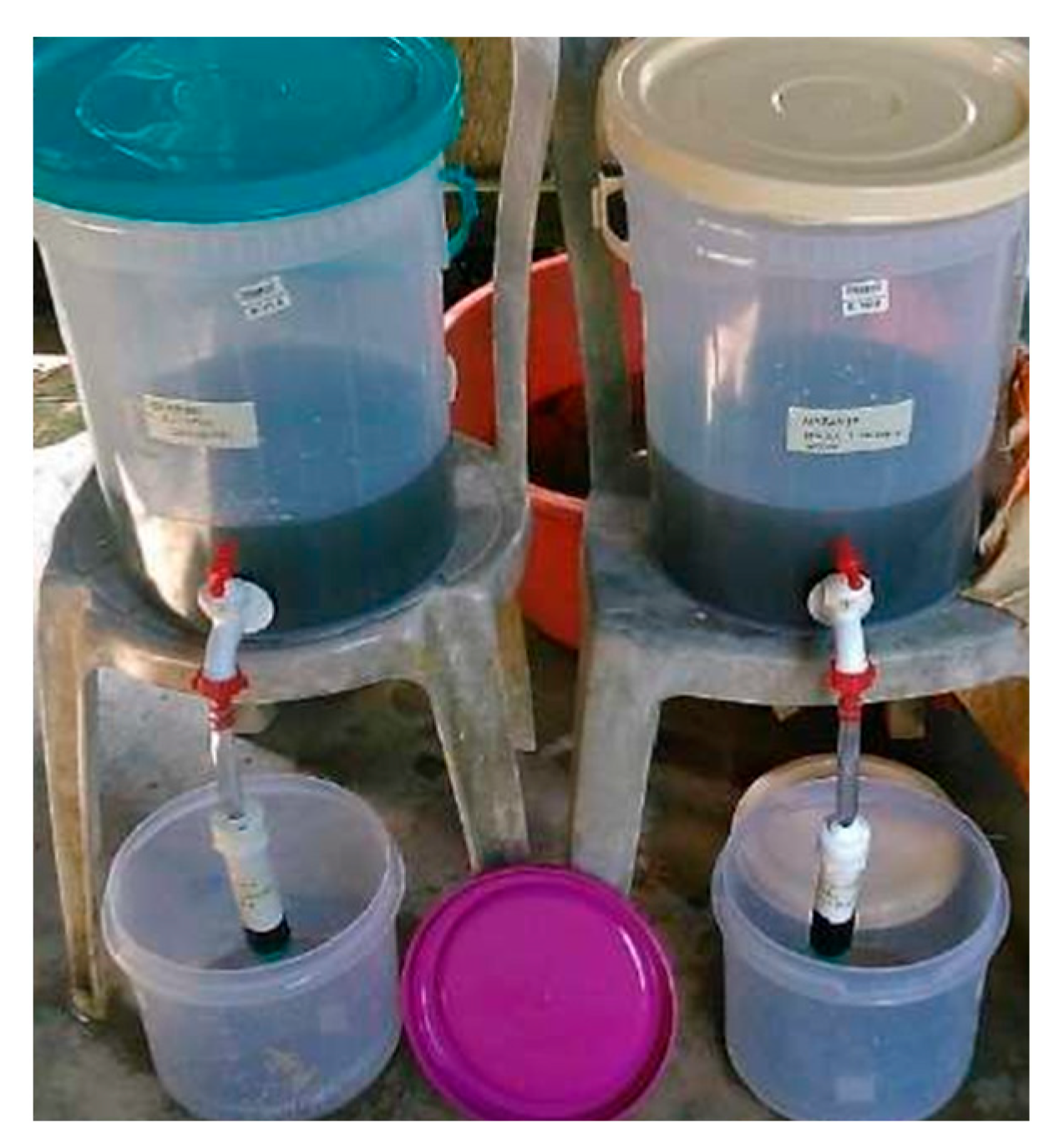
Appendix B
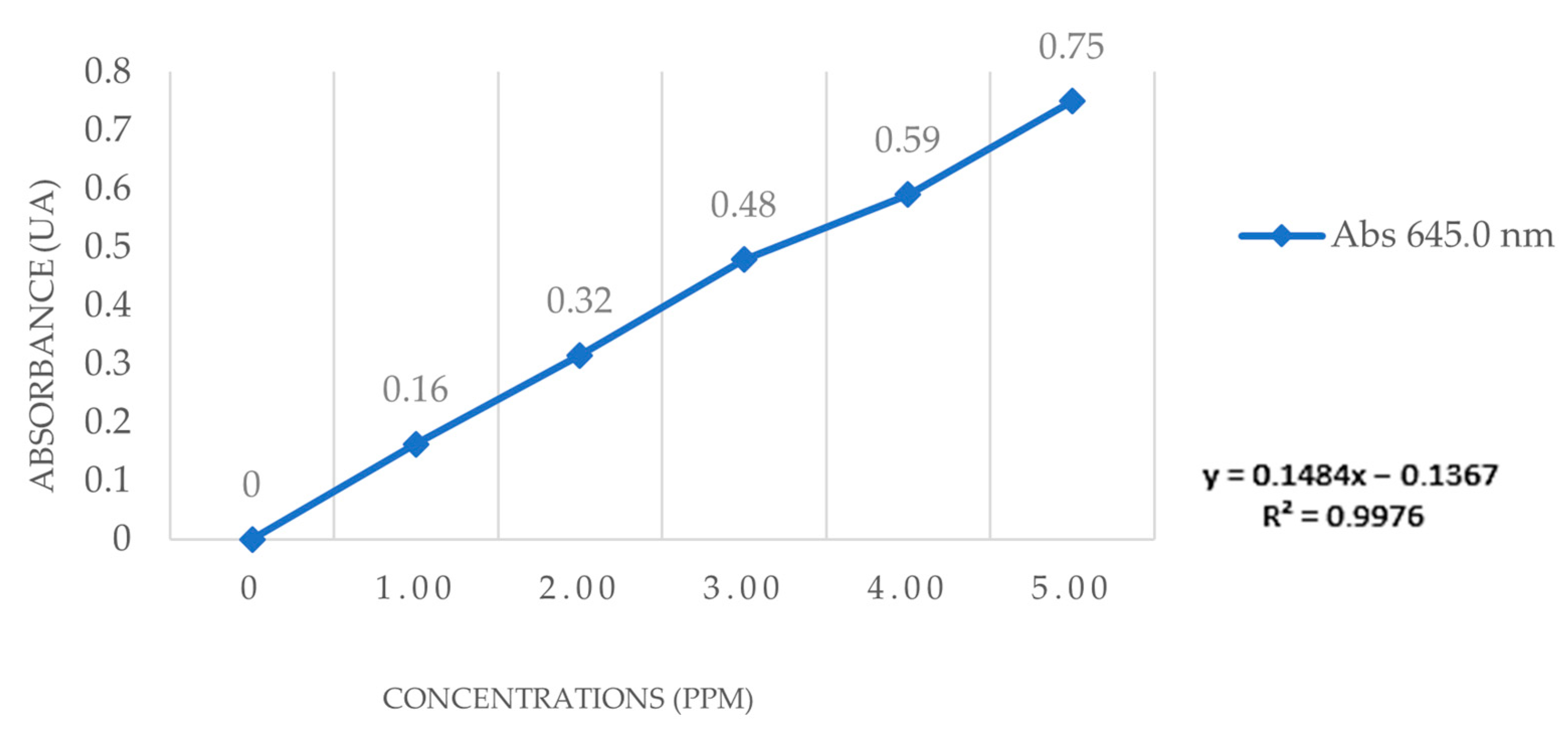
Appendix C
| Test 1. Aloe Vera 1% solution | Test 2. Aloe Vera 1% solution | ||||||||||
| Jar test | Dosage [mg L−1] | Initial Turbidity [NTU] | Final Turbidity [NTU] | Initial pH | Final pH | Jar test | Dosage [mg L−1] | Initial Turbidity [NTU] | Final Turbidity [NTU] | Initial pH | Final pH |
| 1 | - | 47.84 | 36.19 | 6.91 | 6.73 | 1 | - | 47.84 | 36.19 | 6.91 | 6.73 |
| 2 | 5 | 49.43 | 28.78 | 6.85 | 6.86 | 2 | 2.5 | 46.24 | 31.48 | 6.96 | 6.80 |
| 3 | 10 | 49.43 | 28.66 | 6.85 | 6.84 | 3 | 5 | 46.24 | 33.61 | 6.96 | 6.86 |
| 4 | 15 | 49.43 | 30.05 | 6.85 | 6.91 | 4 | 7.5 | 46.24 | 30.87 | 6.96 | 6.89 |
| 5 | 20 | 49.43 | 29.76 | 6.85 | 6.95 | 5 | 10 | 46.24 | 28.84 | 6.96 | 6.93 |
| 6 | 25 | 49.43 | 29.90 | 6.85 | 6.92 | 6 | 12.5 | 46.24 | 32.91 | 6.96 | 6.96 |
| Test 1. Aluminum Sulphate 1% solution | Test 2. Aluminum Sulphate 1% solution | ||||||||||
| Jar test | Dosage [mg L−1] | Initial Turbidity [NTU] | Final Turbidity [NTU] | Initial pH | Final pH | Jar test | Dosage [mg L−1] | Initial Turbidity [NTU] | Final Turbidity [NTU] | Initial pH | Final pH |
| 1 | - | 40.42 | 30.79 | 6.78 | 6.83 | 1 | - | 48.67 | 37.13 | 6.87 | 6.83 |
| 2 | 10 | 40.42 | 31.19 | 6.78 | 6.52 | 2 | 7.5 | 48.67 | 28.40 | 6.87 | 6.43 |
| 3 | 20 | 40.42 | 30.85 | 6.78 | 6.10 | 3 | 15 | 48.67 | 27.78 | 6.87 | 6.02 |
| 4 | 30 | 40.42 | 28.285 | 6.78 | 5.39 | 4 | 22.5 | 48.67 | 29.90 | 6.87 | 5.81 |
| 5 | 40 | 40.42 | 36.10 | 6.78 | 3.79 | 5 | 30 | 24.34 | 27.08 | 6.87 | 5.26 |
| 6 | 50 | 40.42 | 38.43 | 6.78 | 3.79 | 6 | 37.5 | 48.67 | 33.55 | 6.87 | 4.48 |
References
- WHO. Guidelines for the Safe Use of Wastewater, Excreta and Greywater; World Health Organization: Geneva, Switzerland, 2006; Volume 2, p. 204. [Google Scholar]
- Massoud, M.A.; Tarhini, A.; Nasr, J.A. Decentralized Approaches to Wastewater Treatment and Management: Applicability in Developing Countries. J. Environ. Manag. 2009, 90, 652–659. [Google Scholar] [CrossRef]
- Collivignarelli, M.C.; Carnevale Miino, M.; Gomez, F.H.; Torretta, V.; Rada, E.C.; Sorlini, S. Horizontal Flow Constructed Wetland for Greywater Treatment and Reuse: An Experimental Case. Int. J. Environ. Res. Public Health 2020, 17, 2317. [Google Scholar] [CrossRef] [PubMed]
- Capodaglio, A. Integrated, Decentralized Wastewater Management for Resource Recovery in Rural and Peri-Urban Areas. Resources 2017, 6, 22. [Google Scholar] [CrossRef]
- Collivignarelli, M.C.; Gomez, F.H.; Caccamo, F.M.; Sorlini, S. Reduction of Pathogens in Greywater with Biological and Sustainable Treatments Selected through a Multicriteria Approach. Environ. Sci. Pollut. Res. 2022, 30, 38239–38254. [Google Scholar] [CrossRef]
- Puyol, D.; Batstone, D.J.; Hülsen, T.; Astals, S.; Peces, M.; Krömer, J.O. Resource Recovery from Wastewater by Biological Technologies: Opportunities, Challenges, and Prospects. Front. Microbiol. 2017, 7, 2106. [Google Scholar] [CrossRef] [PubMed]
- Khan, S.A.R.; Ponce, P.; Yu, Z.; Golpîra, H.; Mathew, M. Environmental technology and wastewater treatment: Strategies to achieve environmental sustainability. Chemosphere 2022, 286, 131532. [Google Scholar] [CrossRef]
- Crini, G.; Lichtfouse, E. Advantages and Disadvantages of Techniques Used for Wastewater Treatment. Environ. Chem. Lett. 2019, 17, 145–155. [Google Scholar] [CrossRef]
- Geissdoerfer, M.; Savaget, P.; Bocken, N.M.P.; Hultink, E.J. The Circular Economy—A New Sustainability Paradigm? J. Clean. Prod. 2017, 143, 757–768. [Google Scholar] [CrossRef]
- Hernández-Chover, V.; Castellet-Viciano, L.; Fuentes, R.; Hernández-Sancho, F. Circular Economy and Efficiency to Ensure the Sustainability in the Wastewater Treatment Plants. J. Clean. Prod. 2023, 384, 135563. [Google Scholar] [CrossRef]
- Gomez, F.H.; Pelegri, N.; Lopez, J.G.; Torres, K.C.; Vaccari, M. Impact of Artisanal Gold Mining in Community Conserved Areas with High Biodiversity Using a Multi-Criteria Approach: A Case Study in Colombia. Pollutants 2024, 4, 276–290. [Google Scholar] [CrossRef]
- ACVC Asociación Campesina del Valle del Río Cimitarra; Instituto Colombiano de Desarrollo Rural; Corporación De-sarrollo y Paz del Magdalena Medio. Actualización del Plan de Desarrollo Sostenible ZRC-VRC. Barrancabermeja (Colombia). 2012. Available online: https://reservacampesinariocimitarra.org/wp-content/uploads/2022/07/PLAN-DE-DESARROLLO-ZRC-VALLE-RIO-CIMITARRA-2_compressed.pdf (accessed on 5 May 2025).
- Katubi, K.M.; Amari, A.; Harharah, H.N.; Eldirderi, M.M.; Tahoon, M.A.; Ben Rebah, F. Aloe vera as a promising material for water treatment: A review. Processes 2021, 9, 782. [Google Scholar] [CrossRef]
- da Silva, R.M.P.; de Farias, B.S.; Fernandes, S.S. From Natural to Industrial: How Biocoagulants Can Revolutionize Wastewater Treatment. Processes 2025, 13, 1706. [Google Scholar] [CrossRef]
- Benalia, A.; Ismaili, M.; Meftah, H.; Elouahli, A. Aloe vera powder and liquid extract as natural coagulants for drinking water treatment. Water 2021, 13, 2024. [Google Scholar] [CrossRef]
- Ramírez Arcila, H.; Jaramillo Peralta, J. Agentes Naturales Como Alternativa Para El Tratamiento Del Agua. Rev. Fac. Ciencias Básicas 2016, 11, 136. [Google Scholar] [CrossRef]
- Ang, W.L.; Mohammad, A.W. State of the Art and Sustainability of Natural Coagulants in Water and Wastewater Treatment. J. Clean. Prod. 2020, 262, 121267. [Google Scholar] [CrossRef]
- Gomez, F.H.; Collivignarelli, M.C.; Bellazzi, S.; Torres, K.C.; Sorlini, S.; Vaccari, M. Mercury Removal from Mining Wastewater by Bioaccumulation and Thermal Separation in Eichhornia crassipes. Environ. Sci. Pollut. Res. 2024, 32, 798–810. [Google Scholar] [CrossRef]
- Rasool, S.; Ahmad, I.; Jamal, A.; Saeed, M.F.; Zakir, A.; Abbas, G.; Seleiman, M.F.; Caballero-Calvo, A. Evaluation of Phytoremediation Potential of an Aquatic Macrophyte (Eichhornia crassipes) in Wastewater Treatment. Sustainability 2023, 15, 11533. [Google Scholar] [CrossRef]
- Hayyat, M.U.; Nawaz, R.; Irfan, A.; Al-Hussain, S.A.; Abbas, G.; Seleiman, M.F. Phytoremediation of chromium and lithium-contaminated wastewater using Eichhornia crassipes. Int. J. Environ. Res. Public Health 2023, 20, 3512. [Google Scholar] [CrossRef]
- Stefanakis, A. The Role of Constructed Wetlands as Green Infrastructure for Sustainable Urban Water Management. Sustainability 2019, 11, 6981. [Google Scholar] [CrossRef]
- Rezania, S.; Ponraj, M.; Din, M.F.M.; Songip, A.R.; Sairan, F.M.; Chelliapan, S. The Diverse Applications of Water Hyacinth with Main Focus on Sustainable Energy and Production for New Era: An Overview. Renew. Sustain. Energy Rev. 2015, 41, 943–954. [Google Scholar] [CrossRef]
- Brix, H. Do Macrophytes Play a Role in Constructed Treatment Wetlands? Water Sci. Technol. 1997, 35, 11–17. [Google Scholar] [CrossRef]
- Kateregga, E.; Sterner, T. Indicators for an invasive species: Water hyacinths in Lake Victoria. Ecol. Indic. 2007, 7, 362–370. [Google Scholar] [CrossRef]
- Zhang, Q.H.; Yang, W.N.; Ngo, H.H.; Guo, W.S.; Jin, P.K.; Dzakpasu, M.; Yang, S.J.; Wang, Q.; Wang, X.C.; Ao, D. Current Status of Urban Wastewater Treatment Plants in China. Environ. Int. 2016, 92–93, 11–22. [Google Scholar] [CrossRef]
- Montero-Martínez, M.J.; del Refugio Castañeda-Chávez, M.; Lango-Reynoso, F.; Navarrete-Rodríguez, G.; Mar-tínez-Cárdenas, L. Removal of Pathogenic Bacteria in a Horizontally Fed Subsurface Constructed Wetland Hybrid System. J 2023, 6, 492–507. [Google Scholar] [CrossRef]
- MAL, R.; Isolino Sampaio, P.; Parolin, P. Biofilter Efficiency of Eichhornia crassipes in Wastewater Treatment of Fish Farming in Amazonia. Phyton 2015, 84, 244–251. [Google Scholar] [CrossRef]
- Shruthi, R. Optimizing Horizontal Subsurface Flow Constructed Wetlands for Rural Wastewater Treatment: A Box-Behnken Design Approach. Preprint 2024. [Google Scholar] [CrossRef]
- Miranda, S.T.; de Matos, A.T.; Matos, M.P.; Saraiva, C. Efficiency of Horizontal Subsurface Flow-Constructed Wetlands Considering Different Support Materials and the Cultivation Positions of Plant Species. Rev. Ambient. Agua Interdiscip. J. Appl. Sci. 2020, 15, 1. [Google Scholar] [CrossRef]
- Reynel-Ávila, H.E.; Aguayo-Villarreal, I.A.; Diaz-Muñoz, L.L.; Moreno-Pérez, J.; Sánchez-Ruiz, F.J.; Rojas-Mayorga, C.K.; Mendoza-Castillo, D.I.; Bonilla-Petriciolet, A. A Review of the Modeling of Adsorption of Organic and In-organic Pollutants from Water Using Artificial Neural Networks. Adsorpt. Sci. Technol. 2022, 2022, 1–51. [Google Scholar] [CrossRef]
- Otero, M.; Freire, L.; Gómez-Cuervo, S.; Ávila, C. Ammonium Removal in Wastewater Treatments by Adsorbent Geopolymer Material with Granite Wastes: Full-Scale Validation. Clean Technol. 2024, 6, 339–364. [Google Scholar] [CrossRef]
- Razali, N.S.; Abdulhameed, A.S.; Jawad, A.H.; ALOthman, Z.A.; Yousef, T.A.; Al-Duaij, O.K.; Alsaiari, N.S. High-Surface-Area-Activated Carbon Derived from Mango Peels and Seeds Wastes via Microwave-Induced ZnCl2 Activation for Adsorption of Methylene Blue Dye Molecules: Statistical Optimization and Mechanism. Molecules 2022, 27, 6947. [Google Scholar] [CrossRef]
- Solís-Fuentes, J.A.; Hernández-Medel, M.d.R.; Durán-de-Bazúa, M.d.C. Soursop (Annona muricata L.) Seeds, Therapeutic and Possible Food Potential. In Nuts and Seeds in Health and Disease Prevention; Elsevier: Amsterdam, The Netherlands, 2011; pp. 1045–1052. [Google Scholar]
- O’Carroll, D.M.; Jeffries, T.C.; Lee, M.J.; Le, S.T.; Yeung, A.; Wallace, S.; Battye, N.; Patch, D.J.; Manefield, M.J.; Weber, K.P. Developing a Roadmap to Determine Per- and Polyfluoroalkyl Substances-Microbial Population Interactions. Sci. Total Environ. 2020, 712, 135994. [Google Scholar] [CrossRef]
- Solís-Fuentes, J.A.; Hernández-Medel, M.d.R.; Durán-de-Bazúa, M.d.C. Soursop Seed. In Nuts and Seeds in Health and Disease Prevention; Elsevier: Amsterdam, The Netherlands, 2020; pp. 15–25. [Google Scholar]
- Acevedo, S.; Giraldo, L.; Moreno-Piraján, J.C. Kinetic Study of CO2 Adsorption of Granular-Type Activated Carbons Prepared from Palm Shells. Environ. Sci. Pollut. Res. 2023, 31, 39839–39848. [Google Scholar] [CrossRef]
- Foo, K.Y.; Hameed, B.H. Coconut Husk Derived Activated Carbon via Microwave Induced Activation: Effects of Activation Agents, Preparation Parameters and Adsorption Performance. Chem. Eng. J. 2012, 184, 57–65. [Google Scholar] [CrossRef]
- Yagub, M.T.; Sen, T.K.; Afroze, S.; Ang, H.M. Dye and Its Removal from Aqueous Solution by Adsorption: A Review. Adv. Colloid Interface Sci. 2014, 209, 172–184. [Google Scholar] [CrossRef] [PubMed]
- NTC 3903; Procedure for Coagulation-Floculation Testing in a Container with Water or Jar Method. ICONTEC: Bogota, Colombia, 2010. Available online: https://www.icontec.org/ (accessed on 13 October 2025).
- 5220 C; Chemical Oxygen Demand (COD)—Closed Reflux, Titrimetric Method. APHA, AWWA, WEF: Washington, DC, USA, 2017.
- 5210 B/C; Biochemical Oxygen Demand (BOD5)—5-Day Test (Dissolved Oxygen Depletion Method). APHA, AWWA, WEF: Washington, DC, USA, 2017.
- 4500-P; Phosphorus—Persulfate Digestion Method, Ascorbic Acid Method (Colorimetric Determination). APHA, AWWA, WEF: Washington, DC, USA, 2017.
- 4500-H+; Hydrogen Ion (PH)—Potentiometric Method with Glass Electrode. APHA, AWWA, WEF: Washington, DC, USA, 2017.
- 2130 B; Turbidity—Nephelometric Method (Formazin Calibration). APHA, AWWA, WEF: Washington, DC, USA, 2017.
- 9222 D; Fecal Coliform—Membrane Filtration Technique on m-FC Agar at 44.5 °C (or 9221B/C Multiple-Tube Method). APHA, AWWA, WEF: Washington, DC, USA, 2017.
- 9222 G; Fecal and Total Coliforms—Membrane Filtration Using Selective Media/Enzyme Substrate Test. APHA, AWWA, WEF: Washington, DC, USA, 2017.
- 9215 B/C; Heterotrophic Plate Count—Pour or Spread Plate Method Using Plate Count Agar (PCA) or Reasoner’s 2A Agar (R2A). APHA, AWWA, WEF: Washington, DC, USA, 2017.
- Gomez, F.H.; Collivignarelli, M.C.; Masoud, A.M.N.; Carnevale Miino, M.; Torres, K.C.; Quintero, J.A.; Sorlini, S.; Vaccari, M. Mercury Removal from Mining Wastewater by Phytoaccumulation in Autochthonous Aquatic Plant Species. Clean Technol. 2023, 5, 839–851. [Google Scholar] [CrossRef]
- Tsimnadis, K.; Katsenios, G.; Fanourakis, S.; Kyriakopoulos, G.L.; Kyriakakis, A.; Kyriakakis, D.; Tsagkaropoulos, D. Evalu-ating the Effects of Irrigation with Reused Water and Compost from a Pilot Wastewater Treatment Unit on the Experi-mental Growth of Two Common Ornamental Plant Species in the City of Athens. Clean Technol. 2025, 7, 13. [Google Scholar] [CrossRef]
- Von Sperling, M. Relationship between First-Order Decay Coefficients in Ponds, for Plug Flow, CSTR and Dispersed Flow Regimes. Water Sci. Technol. 2002, 45, 17–24. [Google Scholar] [CrossRef]
- Báez, L.C.; Muñoz, C.F.P.; Crespo-Barrera, P.M.; Venegas, P.O.; Bahena, A.M.; Navarro-Frometa, A.E. Development of a simple and low-cost method for the elimination of indicator bacteria from domestic wastewater discharges to the Huacapa River in Guerrero, Mexico. Water Air Soil Pollut. 2024, 235, 552. [Google Scholar] [CrossRef]
- Ausland, G.; Stevik, T.K.; Hanssen, J.F.; Køhler, J.C.; Jenssen, P.D. Intermittent filtration of astewater—Removal of fecal coliforms and fecal streptococci. Water Res. 2002, 36, 3507–3516. [Google Scholar] [CrossRef]
- Ghebremichael, K.A.; Gunaratna, K.R.; Henriksson, H.; Brumer, H.; Dalhammar, G. A Simple Purification and Activity Assay of the Coagulant Protein from Moringa oleifera Seed. Water Res. 2005, 39, 2338–2344. [Google Scholar] [CrossRef]
- Huang, X. The Promotion of Anaerobic Digestion Technology Upgrades in Waste Stream Treatment Plants for Circular Economy in the Context of “Dual Carbon”: Global Status, Development Trend, and Future Challenges. Water 2024, 16, 3718. [Google Scholar] [CrossRef]

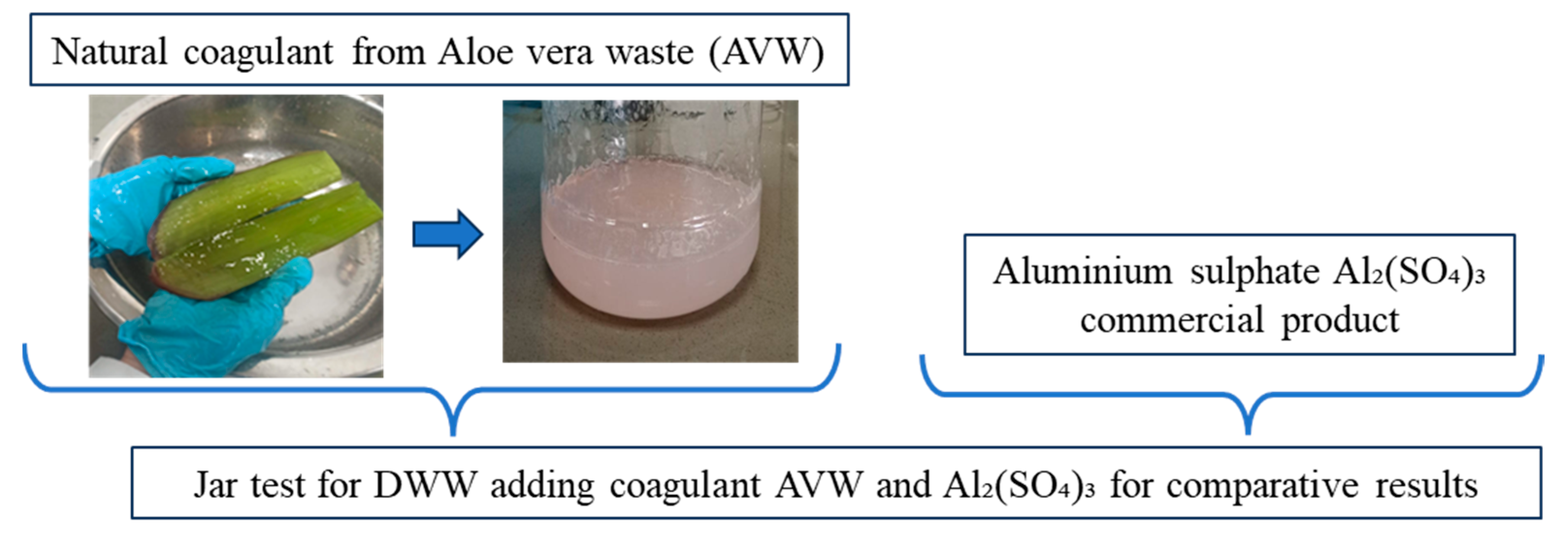


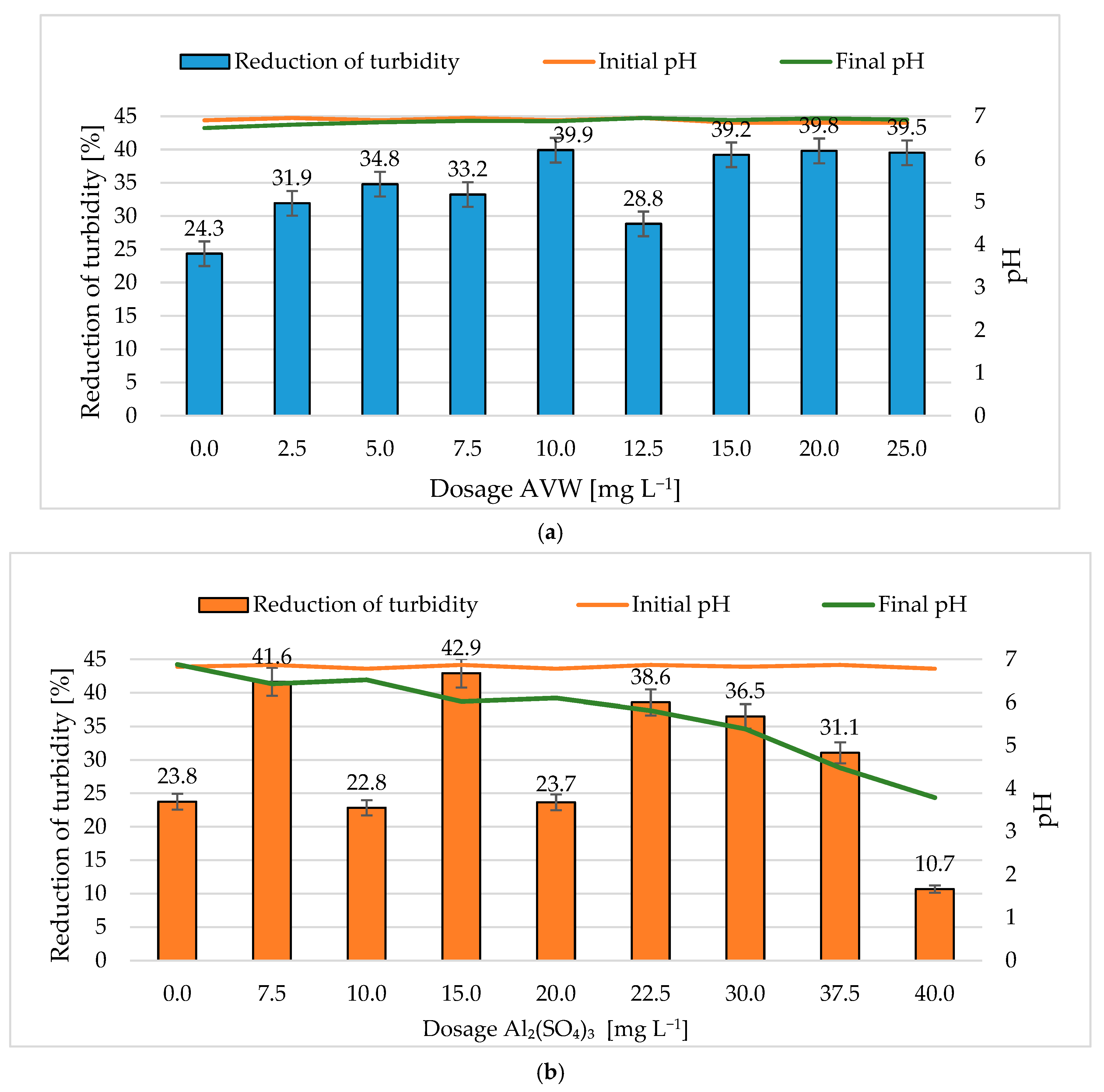
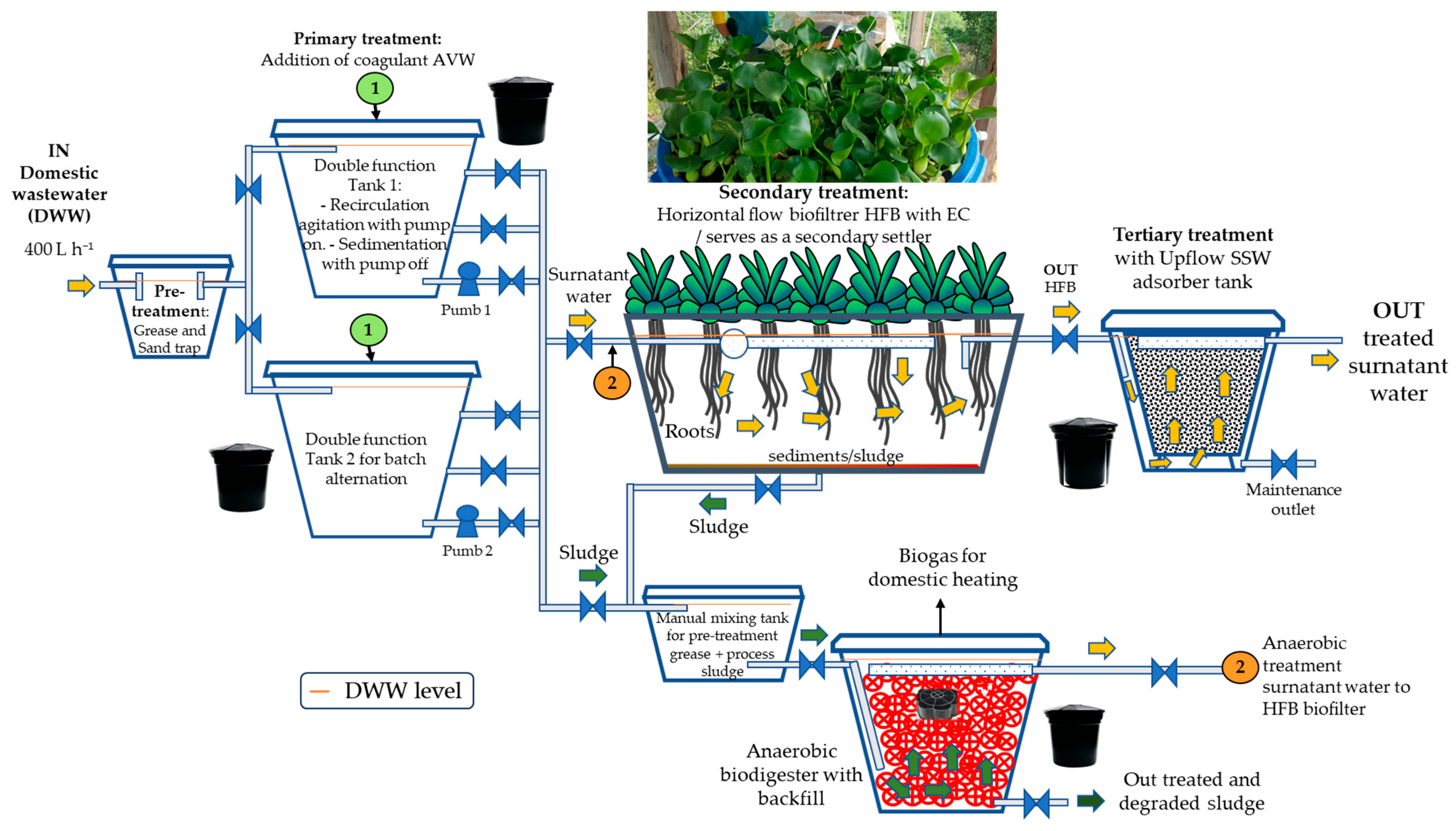
| Parameter | Value | Unit of Measurement | Standard Method (APHA) and Principle |
|---|---|---|---|
| COD | 617 | mg L−1 | 5220 C—Closed reflux, titrimetric (oxidation with dichromate, back titration, or colorimetric) [40] |
| BOD5 | 365 | mg L−1 | 5210 B/C—5-day BOD test (incubation at 20 °C, dissolved oxygen depletion measurement) [41] |
| TP | 1.27 | mg L−1 | 4500-P (persulfate digestion, ascorbic acid method)—Colorimetric determination [42] |
| pH | 6.5 | - | 4500-H+—Potentiometric with glass electrode [43] |
| Turbidity | 325 | Nephelometric Turbidity Unit (NTU) | 2130 B—Nephelometric method [44] |
| Fecal coliform | 3900 | Most Probable Number (MPN) 100 mL−1 | 9222 D—Membrane filtration on m-FC agar at 44.5 °C (or 9221B/C multiple-tube) [45] |
| Escherichia coli | 110 | MPN 100 mL−1 | 9222 G—Membrane filtration with selective media/enzyme substrate test [46] |
| Heterotrophic bacteria | 29 × 104 | Colony Forming Unit (CFU) 100 mL−1 | 9215 B/C—Heterotrophic plate count (pour/spread plate on plate count agar or Reasoner’s 2A agar) [47] |
| Operating Parameters | SSW Adsorbent | Activated Carbon Commercial |
|---|---|---|
| Dose filter material [g] | 50 | 50 |
| Ps [g∙L−1] | 470 | 625 |
| W [L] = Dose/Ps | 0.106 | 0.08 |
| Q [mL min−1] | 10 | 10 |
| EBCT [min] | 10.64 | 8.68 |
| Parameter | Units | Minimun Limit of the Measure | Average Value Obtained IN | Average Value Obtained OUT (3 Samples) | % of Removal |
|---|---|---|---|---|---|
| Fecal Coliform | MNP/100 mL | 1 | 3900 | 80 | 97.9 |
| Escherichia coli (E. coli) | 110 | 19.3 | 82.4 | ||
| Heterotrophic bacteria | CFU/100 mL | 1 | 29 × 104 | 200 | 99.9 |
| Parameter | Column with Commercial Active Carbon | Column with SSW Adsorbent | ||||
|---|---|---|---|---|---|---|
| - | IN | OUT | % Removal | IN | OUT | % Removal |
| pH 6 h | 7.2 | 6.9 | - | 6.8 | 6.3 | - |
| Turbidity [NTU] 6 h | 325 | 60.3 | 81.4 | 356 | 9.02 | 97.5 |
| Turbidity [NTU] 12 h | 325 | 107 | 67.1 | 356 | 6.3 | 98.2 |
| Qout end test [mL min−1] | 7.716 | - | 6.211 | - | ||
| EBCT start test [min] | 10.6 | - | 8.7 | - | ||
| EBCT end test [min] | 13.8 | - | 12.6 | - | ||
Disclaimer/Publisher’s Note: The statements, opinions and data contained in all publications are solely those of the individual author(s) and contributor(s) and not of MDPI and/or the editor(s). MDPI and/or the editor(s) disclaim responsibility for any injury to people or property resulting from any ideas, methods, instructions or products referred to in the content. |
© 2025 by the authors. Licensee MDPI, Basel, Switzerland. This article is an open access article distributed under the terms and conditions of the Creative Commons Attribution (CC BY) license (https://creativecommons.org/licenses/by/4.0/).
Share and Cite
Gomez, F.H.; Collivignarelli, M.C.; Bellazzi, S.; Torres, K.C.; Abbà, A.; Sorlini, S. Sequential Treatment of Domestic Wastewater in Rural Zones Applying Aloe Vera Extract as Coagulant (Preliminar), E. crassipes in a Horizontal Biofilter (Secondary), and Activated Carbon from Soursop Seeds (Tertiary). Clean Technol. 2025, 7, 105. https://doi.org/10.3390/cleantechnol7040105
Gomez FH, Collivignarelli MC, Bellazzi S, Torres KC, Abbà A, Sorlini S. Sequential Treatment of Domestic Wastewater in Rural Zones Applying Aloe Vera Extract as Coagulant (Preliminar), E. crassipes in a Horizontal Biofilter (Secondary), and Activated Carbon from Soursop Seeds (Tertiary). Clean Technologies. 2025; 7(4):105. https://doi.org/10.3390/cleantechnol7040105
Chicago/Turabian StyleGomez, Franco Hernan, Maria Cristina Collivignarelli, Stefano Bellazzi, Kelly Cristina Torres, Alessandro Abbà, and Sabrina Sorlini. 2025. "Sequential Treatment of Domestic Wastewater in Rural Zones Applying Aloe Vera Extract as Coagulant (Preliminar), E. crassipes in a Horizontal Biofilter (Secondary), and Activated Carbon from Soursop Seeds (Tertiary)" Clean Technologies 7, no. 4: 105. https://doi.org/10.3390/cleantechnol7040105
APA StyleGomez, F. H., Collivignarelli, M. C., Bellazzi, S., Torres, K. C., Abbà, A., & Sorlini, S. (2025). Sequential Treatment of Domestic Wastewater in Rural Zones Applying Aloe Vera Extract as Coagulant (Preliminar), E. crassipes in a Horizontal Biofilter (Secondary), and Activated Carbon from Soursop Seeds (Tertiary). Clean Technologies, 7(4), 105. https://doi.org/10.3390/cleantechnol7040105









